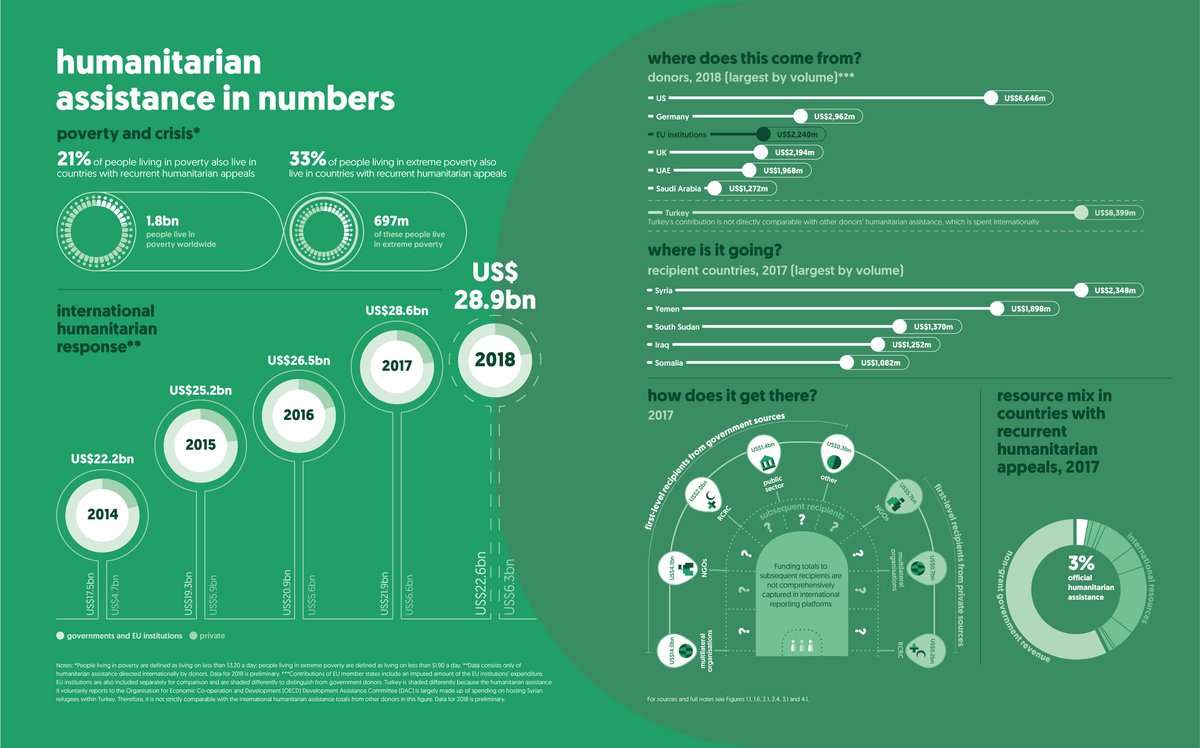In 2018, an estimated 206.4 million people living in 81 countries were deemed in need of humanitarian assistance. A large portion of these people continued to be concentrated in a small number of countries: six countries accounted for 80.6 million people in need. The well-established trend of a small number of crises receiving a large proportion of all humanitarian assistance continued. Ten countries received 63% (or US$11.8 million) of all country-allocable humanitarian assistance in 2017.
Crises are frequently protracted. Between 2000 and 2017, 27 countries had more than 5 consecutive years of UN-coordinated appeals. Of these countries, 16 still had appeals in 2018. Recurrent crisis disproportionately impacts people in poverty. A third of the global population living in extreme poverty (on less than $1.90 per day) are in countries with UN-coordinated appeals in 2018 and consecutively for at least one preceding year. Crises are also often complex. Nine of the ten countries with the largest populations in need faced conflict and forced displacement in 2018. Globally the numbers of forcibly displaced people grew for the seventh consecutive year, to 70.8 million in 2018 (a 3% rise from 2017).
International humanitarian assistance from governments and private donors continued to increase in 2018, reaching US$28.9 billion. This represents growth of almost a third since 2014. Yet the pace of growth has slowed, rising by just 1% from 2017 to 2018. Contributions from public donors drove the overall increase in 2018, as preliminary estimates of private contributions indicated a slight decrease.
In 2018, the amount requested through UN-coordinated appeals rose for the third consecutive year, reaching a new high of US$28.1 billion. While a record volume of funding was committed towards these appeals (US$17.0 billion), there was still a funding shortfall of US$11.1 billion, with only 61% of requirements met.
The well-established trend of a relatively small group of governments and EU institutions providing the majority of international humanitarian assistance remains unchanged. The three largest donors continue to be the US, Germany and the UK. These countries accounted for 52% of all government contributions, although contributions from all three decreased in 2018. Among other donors, substantial increases were made by the United Arab Emirates and Saudi Arabia, providing an additional US$1.7 billion (567% rise) and US$806 million (173% rise) in 2018, respectively.
Given the protracted and complex nature of many crises and the strain on available resources, directing a wide range of domestic and international resources to complement humanitarian assistance is important if both immediate and long-term needs are to be met. However, in countries with UN-coordinated appeals in 2017 and consecutively for at least one preceding year, domestic resources are significantly lower than in other developing countries (US$272 per person, compared with almost US$1,000), while international flows per person are over 40% lower.
Developmental official development assistance (ODA less humanitarian assistance) and humanitarian assistance are progressively being channelled to the same protracted crisis contexts. A greater proportion of developmental ODA is being delivered in the form of loans. Protracted crisis response countries (see Chapter 1, Box 1.1) are receiving significantly more lending of all kinds. ODA loans to these countries have grown and at a much faster rate (by 394%) than loans to other developing countries (by 40%) between 2012 and 2017. However, in 2017, 75% of ODA loans went to just 7 of 34 protracted crisis response countries, with many others in this group of 34 receiving little or no lending of this kind.
Protracted crises can have a significant impact on international and domestic private flows, but there is also potential for the private sector to complement humanitarian assistance and improve the management of crises more broadly. Assessment of 27 countries with 5 or more consecutive years of UN-coordinated appeals shows that foreign direct investment can be volatile, and inflows can fall rapidly in the face of a crisis, decreasing on average by 47% in the first year of a crisis. The size of the domestic private sector as a proportion of GDP is also substantially lower for countries with recurrent appeals. Blended finance is growing but remains small, with only a fraction going to protracted crisis and fragile contexts. However, there is also potential for the private sector to assist in managing crises, such as through risk finance mechanisms that contribute to a layered financing strategy that brings together different sources of finance.
The targeting, channels and modalities of humanitarian assistance delivery impact the effectiveness and efficiency with which funding reaches people in need. In 2017, almost two thirds of direct government funding (64%, US$14.0 billion) went to multilateral organisations. Meanwhile, most funding (85%, US$5.7 billion) from private donors was channelled to NGOs. Funding to UN pooled funds doubled between 2013 and 2018 (from US$717 million to US$1,439 million). These funds received 6.4% of all international humanitarian assistance from public donors in 2018.
Unearmarked and multi-year funding allow for resources to be delivered predictably and flexibly. Between 2014 and 2018, unearmarked funding to nine UN agencies increased in volume but decreased incrementally as a proportion of all funding received, from 20% in 2015 to 17% in 2018. In 2018, data collected directly from donors showed that multi-year funding accounted for 37% of their total humanitarian-related contributions, increasing from 33% in 2017. However, improved reporting of volumes and the impact of unearmarked and multi-year funding is still needed.
Cash-transfer programming can enable recipients of humanitarian assistance to choose how best to meet their needs and offer potential gains in dignity. Volumes of humanitarian cash and voucher assistance continued to rise to a record US$4.7 billion in 2018. An increasing proportion of this assistance has been transferred to beneficiaries in the form of cash rather than vouchers since 2015, rising from 55% to 78% in 2018.
* The Executive summary text was updated in April 2020 .
